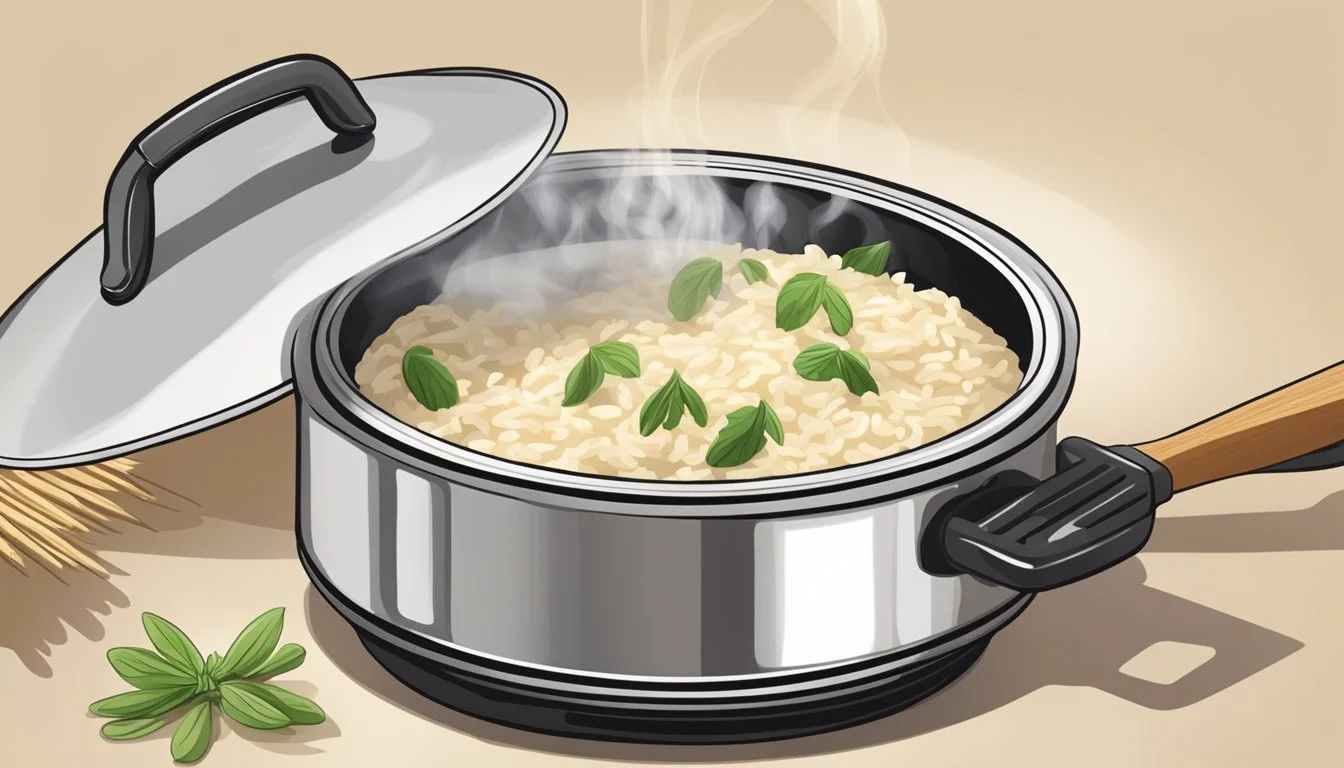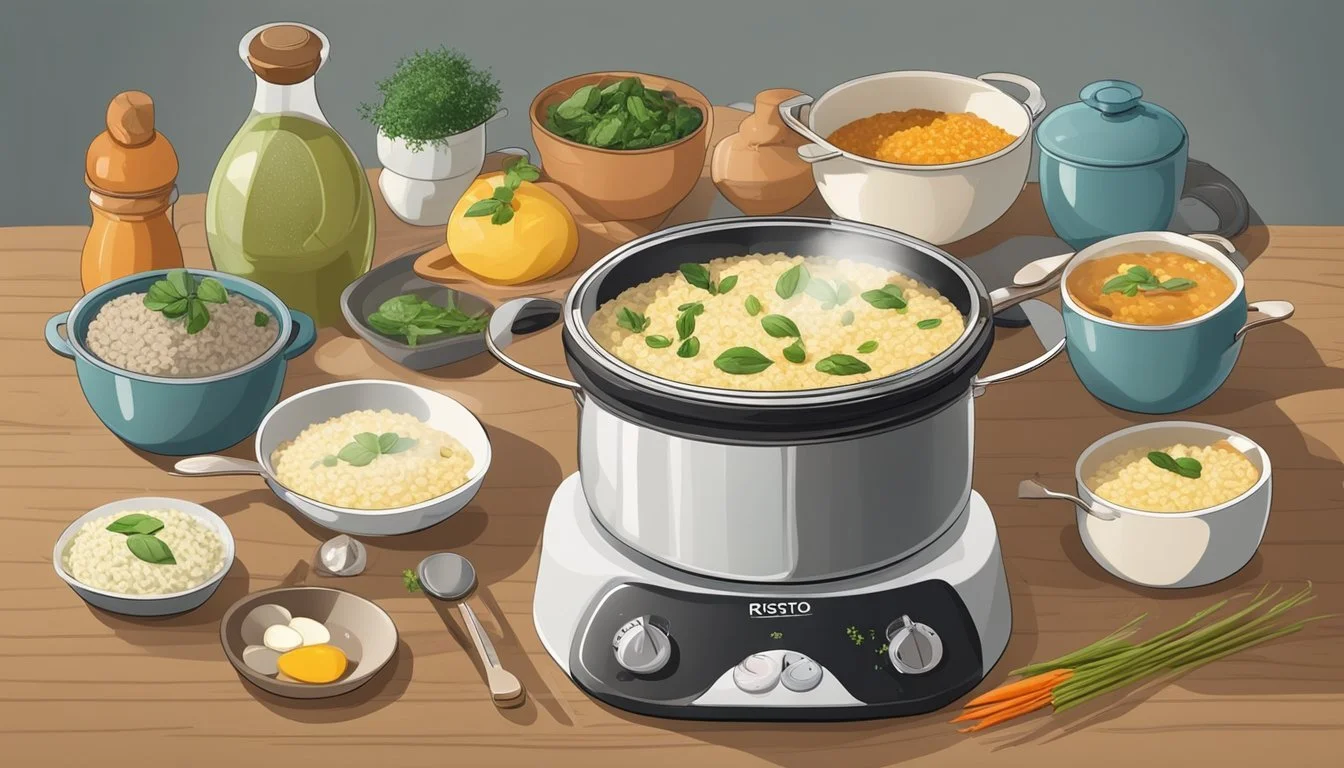How Long Does Freshly Prepared Risotto Last?
Shelf Life and Storage Tips
When it comes to enjoying the creamy, comforting flavors of freshly prepared risotto, understanding its shelf life is key to ensuring both quality and safety. Risotto, a northern Italian rice dish cooked with broth to a creamy consistency, is often best enjoyed immediately after it's made when its texture is just right. However, it's not uncommon to have leftovers, and knowing how long risotto maintains its freshness can help in planning meals accordingly.
Storing risotto in the refrigerator properly can extend its enjoyment. Leftover risotto should be cooled and placed in the refrigerator within two hours of cooking to prevent bacterial growth. Typically, risotto can stay fresh in the fridge for up to three days. During this period, the texture and flavor are most optimal, although slight changes in consistency may be noted as the starches continue to set.
While storing risotto in the freezer is an option for extending its life even further, it should be noted that this can affect its texture. If frozen, risotto is best consumed within two to three months. Thawing and reheating should be done carefully to preserve as much of its original creaminess as possible, using additional broth or water as needed to revive its texture.
Understanding Risotto
Risotto is an Italian rice dish known for its creamy consistency and rich flavor. There are several key ingredients and steps involved in its preparation that contribute to its distinct texture and taste. At its core, risotto utilizes starchy, short-grain rice varieties, such as Arborio, Carnaroli, or Vialone Nano, which are integral in achieving the classic creaminess without the need for actual cream.
The process of cooking risotto involves toasting the rice in butter or olive oil before progressively adding warm stock or broth—often flavored with white wine—stirring continually as the liquid is absorbed. This technique allows the rice to release its starch slowly, creating a lush, creamy sauce-like consistency that's distinctive of a properly cooked risotto.
Parmesan cheese is frequently added at the end of cooking to enhance the flavor and to contribute to the creamy texture of the dish. Despite its richness, risotto typically does not contain cream; the velvety texture is primarily derived from the starch of the rice and the continuous stirring during the cooking process.
Often served as a side dish, risotto can also be a main course, complemented with various ingredients such as vegetables, seafood, or meat. Understanding risotto is not just about recognizing its ingredients or origin, but also appreciating the methodical process of its preparation that is pivotal to its character.
Below is a breakdown of risotto's fundamental elements:
Rice Variety: Arborio, Carnaroli, Vialone Nano
Cooking Fat: Butter, olive oil
Liquid Base: Stock/broth, white wine
Creaminess: Derived from starch, no actual cream
Flavor Enhancers: Parmesan cheese, various mix-ins
Serving: Versatile as a side or a main dish
Risotto stands out as a dish that requires attention and technique, reflecting the culinary art of Italian cooking.
Proper Storage Techniques
Freshly prepared risotto requires careful handling to maintain its quality and safety. Proper storage techniques are critical to extend its shelf life and prevent the growth of bacteria and other harmful pathogens.
Refrigeration
Risotto should be stored in the fridge as soon as it has cooled to minimize bacterial growth. Place the risotto in an airtight container and ensure the seal is secure before placing it in the refrigerator. Properly refrigerated, risotto can generally maintain its quality for 2-3 days.
Freezing Risotto
To freeze risotto, let the dish cool completely and then transfer it to an airtight container or a heavy-duty freezer bag, which can prevent freezer burn and ice crystals from forming. Label the container with the date to keep track of how long it has been stored. Frozen risotto typically lasts for 2-3 months. Do not refreeze risotto once it has been defrosted, as this can compromise its quality and safety.
Preventing Contamination
When storing leftover risotto, whether in the fridge or freezer, it's imperative to avoid cross-contamination with raw foods or other leftovers that may harbor bacteria. Always use clean utensils when serving or transferring risotto to prevent the introduction of spores or toxins. Food safety recommendations from entities like the USDA insist on the importance of keeping cooked and uncooked foods separate, and this also applies to cooked rice (how long does cooked rice last?) dishes like risotto.
Risotto Shelf Life
Risotto, a creamy Italian rice dish, has a limited shelf life once prepared. To maintain quality and safety, proper storage methods in the refrigerator or freezer are essential.
In the Refrigerator
Freshly made risotto should be stored in the refrigerator as soon as it has cooled down to room temperature. In the fridge, leftover risotto can remain safe to consume for up to:
3 days
For best results, they should keep the risotto in an airtight container to retain moisture and prevent contamination. It should be noted that while risotto may be safe to eat after day 3, the texture and flavor might not be as appealing.
After Freezing
Freezing risotto is a topic with mixed opinions, though it is technically possible to freeze it. If one decides to freeze risotto, here are key considerations:
Properly stored, frozen risotto can last approximately 2 to 3 months.
Use airtight containers or freezer bags to store portions.
Label each container with the date of freezing.
They should defrost risotto in the refrigerator overnight. Once thawed, the risotto may experience changes in texture due to the freezing process, potentially becoming softer or slightly mushy upon reheating. Therefore, while freezing can extend risotto’s shelf life, it might slightly alter the dish's quality.
Safe Reheating Practices
When reheating risotto, it is essential to retain its creamy texture and to ensure it is heated to a safe temperature. The appropriate reheating method can make a significant difference in the outcome.
Stovetop Method
To reheat risotto on the stove, one should use low heat to avoid scorching. They should add a small amount of liquid—usually broth or water—to the pan. For each cup of risotto, approximately 3 tablespoons of liquid should suffice. The risotto must be stirred frequently during the reheating process to maintain its creamy consistency and prevent sticking. It should take about 4 to 5 minutes to heat evenly.
Microwave Technique
Reheating risotto in the microwave involves adding a splash of broth or water to keep it moist. The risotto should be covered loosely with a lid or microwave-safe plastic wrap to keep in the moisture. Heating in 30-second intervals until the risotto is thoroughly warmed is advisable. After each interval, one should stir the risotto to ensure even heating. The total time will vary depending on the microwave's power and the amount of risotto being reheated.
Alternative Reheating Methods
Though less common, the oven can be an option to reheat risotto. Preheat the oven to 300°F (150°C) and transfer the risotto to an oven-safe dish. Add a bit of liquid, cover the dish with foil, and heat until it’s thoroughly warmed, which could take about 20 minutes. Stirring isn't as necessary here, but one should still check the risotto periodically to ensure it doesn't dry out.
Maximizing Risotto Quality
Freshly prepared risotto is best enjoyed when its creamy texture and rich flavors are intact. It's important to understand how to maintain the risotto's qualities from kitchen to table.
Understanding Risotto's Texture
To preserve risotto's ideal texture, one must acknowledge the crucial role starch plays. As risotto cooks, the stirring process releases starch from the rice, creating the characteristic creaminess. To maintain this quality, balance is key. Excess liquid can dilute the starch, leading to a soup-like consistency, while insufficient stirring may result in an uneven texture. For the best results, use a high-starch rice like Arborio and constantly stir while gradually adding hot stock.
Restoring Creaminess
If risotto loses its intended creamy nature over time, it can be restored with careful reheating. For every cup of risotto, a quarter cup of broth (preferably the low-sodium version of the original stock used) should be heated and stirred into the rice until the ideal warmth and consistency return. Add a knob of cold butter and a sprinkle of freshly grated Parmesan cheese at the end to bring back the sumptuous creaminess without overcooking the rice.
Incorporating Add-Ins
Enhancing risotto with complementary add-ins must be timed to preserve quality. For instance, tender vegetables or delicate proteins like seafood should be cooked separately and added towards the end to prevent overcooking. A classic mushroom risotto (What wine goes well with mushroom risotto?) benefits from pan-roasted mushrooms folded in after the rice reaches optimal creaminess. This ensures robust flavor and texture. Whenever you choose to incorporate cheese, such as grated Parmesan, add it off the heat to allow it to meld seamlessly without causing separation.
Creative Uses for Leftover Risotto
Leftover risotto presents a creative culinary opportunity to repurpose this creamy dish into exciting new meals. There are various ways to transform, pair, or use risotto as a base for further experimentation.
Transforming into New Dishes
One can rejuvenate day-old risotto by shaping it into risotto cakes or arancini. For risotto cakes, combine the leftovers with an egg, breadcrumbs, and fresh herbs, then pan-fry until golden brown. Alternatively, leftover mushroom risotto can be rolled into balls, coated with breadcrumbs, and deep-fried to create delicious arancini, serving as a satisfying snack or appetizer.
Risotto Cakes: Mix with Parmesan, egg, and parsley, then fry.
Arancini: Roll into balls, coat in breadcrumbs, and fry.
Pairing with Other Foods
Leftover risotto can elevate simple meals by acting as a flavorful side dish or mixing it with various proteins and vegetables. Stirring in sautéed onions, chunks of roasted cauliflower, or a mix of lentils can give it a fresh identity. For a richer experience, fold in cream or cheese to the risotto and serve alongside a protein of choice to create a complete meal.
Side Dish: Combine with vegetables or lentils.
Protein Pairing: Serve with chicken, fish, or tofu.
Risotto as a Base for Experimentation
Risotto's versatility lies in its ability to blend with different grains like farro or barley, resulting in a unique texture and flavor profile. One can experiment by substituting some rice grains with these alternatives or even creating a risotto-style dish with them. Adding vegetable broth to moisten the leftovers can make it creamy again, repairing any stickiness or gluey texture that often accompanies refrigerated risotto.
Grain Variations: Mix with farro, barley, or additional arborio rice.
Re-Moisturizing: Use vegetable broth to restore creaminess.
Health and Safety Concerns
When handling leftover risotto, understanding how to identify spoilage and acknowledging the risks associated with improper storage are crucial to prevent foodborne illnesses. Risotto's moist and nutrient-rich environment is conducive for bacterial growth if not stored correctly.
Identifying Spoiled Risotto
Spoiled risotto often manifests signs that are detectable through the senses. Visual cues such as mold growth or an abnormal change in color are clear indicators. In terms of smell, off odors not typical of creamy risotto suggest contamination and spoilage. Touching risotto may also reveal a slimy consistency, which is another hint that the risotto is no longer safe to consume.
Risks of Improper Storage
Improper storage of risotto can lead to the proliferation of bacteria and the formation of toxins. The culprit is often Bacillus cereus, bacteria that produce spores and toxins capable of surviving even after the risotto is cooked.
Temperature: Risotto should be refrigerated within two hours of cooking to prevent the growth of bacteria.
Airtight Containers: Storing risotto in an airtight container is imperative to limit exposure to air, which can contribute to the deterioration of the food.
USDA Guidelines: The United States Department of Agriculture (USDA) endorses these practices and suggests that risotto, like other cooked leftovers, should be refrigerated at 40°F or below and consumed within 3-4 days for maximum safety.
Food bloggers and experts may provide a variety of tips for storage, but it is essential to align with USDA food safety recommendations to minimize the risk of consuming spoiled or harmful food.
Frequently Asked Questions
Preserving the quality and safety of risotto after it is prepared is of utmost importance. Explore common inquiries on maintaining, reheating, and storing risotto to ensure both flavor and food safety standards are met.
Can Risotto Be Refrozen?
It is not recommended to refreeze risotto. Freezing risotto more than once can cause the texture to degrade and increase the risk of bacterial growth. If risotto has been thawed in the refrigerator and remains cold, it's safer to consume it rather than attempting to refreeze.
What Are the Signs of Bad Risotto?
Risotto that has gone bad will exhibit a sour or unpleasant odor, visible mold, a change in texture to overly slimy, or discoloration. It's crucial to toss risotto if any signs of spoilage are detected, as consuming it can lead to foodborne illness due to bacteria and toxins.
How Can the Flavor of Risotto Be Enhanced When Reheating?
Upon reheating, risotto may lose some of its original flavors and creaminess. To revive its taste, gently reheat it on the stove with a splash of stock, a dollop of butter, or a touch of cream. Stirring in fresh Parmesan cheese can also enhance both flavor and texture.
How Long Can Risotto Sit at Room Temperature?
Risotto should not sit at room temperature for more than 2 hours. The "danger zone" for bacterial growth is between 40°F and 140°F. After 2 hours, bacteria or spores can proliferate to dangerous levels, producing toxins that are not destroyed by reheating.
What's the Best Way to Thaw Frozen Risotto?
The best method to defrost risotto is in the refrigerator, allowing it to thaw slowly and minimizing the risk of bacterial growth. Alternatively, risotto can be defrosted in the microwave using the defrost setting, but it should be consumed immediately after thawing to ensure safety and quality.
Conclusion
Proper storage of risotto extends its shelf life while maintaining its quality. In the refrigerator, risotto remains safe to consume for 3-5 days. For longer storage, one may freeze risotto, which will last for up to 3 months.
Guidelines for Refrigeration:
Store in airtight containers.
Cool down to room temperature before refrigerating.
Guidelines for Freezing:
Use airtight containers or freezer bags.
Mark the date of storage.
Thaw safely before reheating.
When reheating, one should gently warm the risotto on the stovetop with a bit of broth or water to restore its creamy texture. It's important to remember that risotto's quality might change after freezing and thawing, with possible textural differences.
For optimal safety and enjoyment, it is recommended to consume refrigerated risotto within the specified timeframe and always reheat to an internal temperature of 165°F before serving. By following these storage recommendations, risotto enthusiasts can ensure their dish remains delicious and safe to enjoy.











